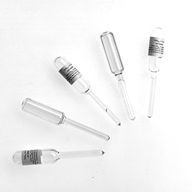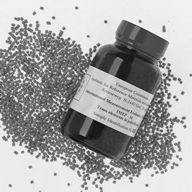
> Quality
of Chemical Measurements
> Europe's Favorite Chemists?
> News and Notices
> Symposia Reports
> New Projects
> Awards and Prizes
> New Books
> Commissions Reports
> Conference
Announcements
> Conference Calendar
Chemistry International
Vol. 23, No. 1
January 2001
Quality of Chemical Measurements (cont')
International Evaluation Program Reveals True Situation
Introduction
Background
The Problem
The BIPM Gets Involved
IRMM’s International Measurement Evaluation Program (IMEP)
A Practical Example: IMEP-9 Trace Elements in Water
The Way ForwardThe comparability of chemical measurement results demands, where possible, that they should be traceable to "stated references" (i.e., values) and preferably expressed in values of the International System of Units (SI–Système International d'Unités). Traceability to such values ensures comparability (results can be validly compared).
Many modern analytical methods are based on comparative techniques that rely on measuring the ratio of an instrumental signal for an unknown sample with that of a known "standard". Very few chemical measurements are being performed with a clearly stated traceability of their results. Accreditation schemes can improve the quality of measurements by making them comply with formal procedures, but the problem of the reliability and degree of equivalence of the results must be addressed, and this issue has been tackled only recently. The essence of the problem lies in applying the principles of Metrology in Chemistry (MiC). Metrology is still rather new in chemistry but will grow according to the increasing emphasis on establishing the degree of equivalence and the need for demonstrating the true reliability of the measurement results.
The International Consultative Committee on Amount of Substance (CCQM–Comité Consultatif pour la Quantité de Matière) was set up in 1995 by the Paris-based International Bureau of Weights and Measures (BIPM–Bureau International des Poids et Mesures). Key tools of MiC are primary methods of measurement, defined by the CCQM as methods for which a complete uncertainty statement can be written down in terms of SI units and whose results are accepted without reference to a standard of the quantity being measured. So far, the CCQM recognizes five such methods, namely, titrimetry, coulometry, gravimetry, determination of freezing point depression, and–most versatile and widely used–isotope dilution mass spectrometry (IDMS), which has been applied and refined at the Institute for Reference Materials and Measurements (IRMM) for over 30 years.
The basis of IDMS is that one measures an unknown number of atoms of an element (or molecules of a compound) in a sample through direct comparison to a known number of atoms of the same element (or molecules of the same compound) in an amount of a spike added.
IRMM’s International Measurement Evaluation Program (IMEP)
In 1988, IRMM founded the International Measurement Evaluation Program (IMEP) as an awareness program and as a tool to show the true state of chemical measurement results, both to practitioners and to end-users of chemical measurements. The IRMM is part of the European Commission’s Joint Research Centre, which is made up of eight research institutes spread over five sites. The mission of the IRMM is to promote a common European measurement system supporting the implementation and monitoring of Community policies, by
- developing and performing specific reference measurements,
- producing Certified Reference Materials (CRMs),
- organizing International Measurement Evaluation Programs,
- establishing community databases,
- performing prenormative research related to European norms or standards, and
- offering special high-level training in measurement sciences.
"IMEP addresses a problem that has long been recognized but has not been resolved" says G. Jeffery Leigh, past-president of the IUPAC Inorganic Chemistry Division. Quoted reproduced from 'Metrology in Chemistry - International program reveals wide variation in chemical measurements', by M. Freemantle, C&EN, 31 May 1999, p. 29-32 or online.
IRMM has developed its expertise and facilities to be able to deliver the highest quality of primary measurements. Host to the largest isotope mass spectrometry facility in Europe, IRMM also has extensive technological material preparation facilities. This unique combination yields Certified Test Samples (CTS) in "real life" matrices fully characterized for homogeneity and stability.
IMEP runs in adherence to the IRMM mission. Today IMEP also runs under the auspices of IUPAC, Analytical Chemistry in Europe (EURACHEM), European Organization of Metrology (EUROMET), and Cooperation on International Traceability in Analytical Chemistry (CITAC).
IMEP enables field laboratories to compare their results against SI-traceable reference values. CTS with undisclosed values are sent to interested participants. The participants are asked to return values together with uncertainty statements claiming in writing to contain so-called "true" values. The undisclosed reference values are established by measurement procedures based (where possible) on IDMS applied as a primary method of measurement. Thus, IMEP basically demonstrates the degree of equivalence of results of chemical measurements for individual laboratories on the international scene as evaluated against results of primary methods of measurement.
- Laboratories evaluate themselves under normal conditions, and they may choose their own techniques, procedures, and instrumentation (preferably routine conditions). They are requested to report their results with a best estimate of combined uncertainty according to ISO/BIPM guidelines.
- IMEP is open to all laboratories, and full confidentiality with respect to results and participant’s identity is guaranteed.
- IMEP focuses on "real life" samples that represent highly important areas (food, environment, health, etc.).
- IMEP graphically displays reference values and results from participating laboratories, but the conclusions are to be drawn by the laboratories themselves. Additional support can be offered by IRMM after the measurement round.
- IMEP is coordinated by IRMM. The establishment of reference values with their uncertainty (which gives a reference range) is a timeconsuming and expensive task. It is accomplished in collaboration with several partners–worldwide "IMEP reference laboratories" that can demonstrate a track record of successful applications of IDMS as a primary method of measurement.
- IMEP is complementary to collaborative studies and proficiency testing schemes; the latter are more frequent, but have a weaker metrological basis. Since 1988, IMEP rounds have mainly concentrated on trace elements in various matrices such as water, polyethylene, serum, and sediment. Thus far, 13 IMEP rounds have been completed, as described in Table 1. At present, IMEP rounds 12, 16, 17, 18, and 19 are ongoing, as listed in Table 2. The first IMEP round, carried out over 10 years ago, addressed the issue of measuring lithium in human serum. Six analytical laboratories at prominent psychiatric institutes were asked to participate. Lithium is administered to patients suffering from mental disorders, and the alarming fact was that all laboratories reported incorrect measurements that were off by a factor of up to five in some cases. One laboratory reported a therapeutic concentration that was actually toxic.
Table 1 Completed IMEP rounds.
Title Time
PeriodPublication IUPAC
Project1 Li in human serum 1988 Fres. Z. Anal. Chem. 332, 718-721 (1988) 2 Cd in polyethylene 1990-91 Fres. Z. Anal. Chem. 345, 310-313 (1993) 3 Trace elements in water 1991-93 Accred. Qual. Assur. 1, 71-82 (1996) 4 Trace elements in bovine serum 1991-95 Accred. Qual. Assur. 3, 447-458 (1998) 240/3/91
5 Fe in human serum 1991-94 Scand. J. Clin. Lab. Invest. 53, Suppl. 212, 38 (1993) 6 Trace elements in water 1994-95 Accred. Qual. Assur. 3, 56-68, (1998) 240/6/93
7 Trace elements in human serum 1997-98 Accred. Qual. Assur. 4, 463-472, (1999) 240/10/96
8 n(13 C)/ n(12 C) and n(18 O)/ n(16 O) in CO 2 1997-99 EUR 19060 EN 9 Trace elements in water 1998-99 EUR 18724 EN 240/12/98
9 Trace elements in water 1998-99 EUR 18724 EN 240/11/97
10 Trace elements in polyethylene 1997-98 IRMM Report GE/R/SIM/11/98 240/8/95
11 Metals in car exhaust catalysts 1998-99 EUR 18735 EN 240/7/95
13 Trace elements in polyethylene 1999-2000 EUR 19562 EN 240/13/98
14 Trace elements in sediments 1999-2000 EUR 19595 EN 240/14/98
Table 2 Ongoing IMEP rounds.
IMEP Title Time Period Status of project 12 Trace elements in water 2000-2001 Samples available in 2001 16 Pb in wine 2000-2001 Samples distributed 17 Trace and minor constituents 2001-2002 Samples available in 2001 18 S in fuel 2001-2002 Samples available in 2001 19 Cd in rice 2001-2002 Samples available in 2001 [More]
News
and Notices - Organizations and People
- Standing Committees
Divisions
- Projects - Reports
- Publications - Symposia
- AMP - Links
Page last modified 29 January 2001.
Copyright © 1997-2001 International Union of Pure and Applied Chemistry.
Questions or comments about IUPAC, please
contact the Secretariat.
Questions regarding the website, please contact [email protected]


